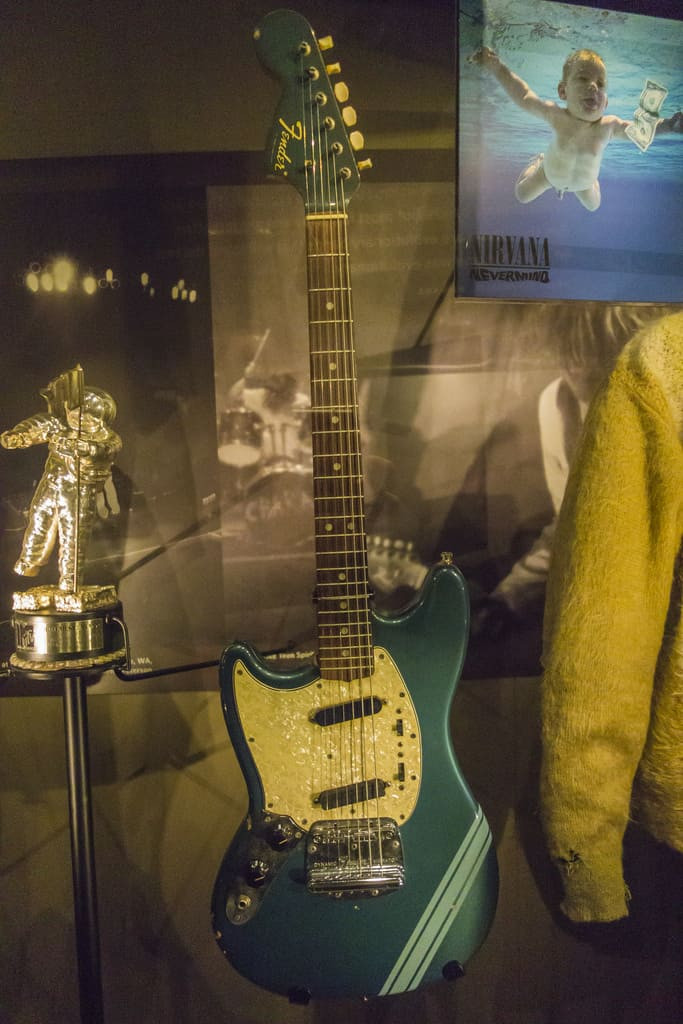Kurt Cobain, the legendary frontman of Nirvana, was known for his raw and powerful sound, heavily influenced by the guitars he played. From budget-friendly models to iconic Fenders, Cobain’s guitar choices mirrored his evolving musical journey and his distinctive style. This article delves into the guitars that shaped the sound of a generation, answering the question: What Guitar Did Kurt Cobain Play?
Early in his career, Cobain favored guitars that were as unconventional and affordable as his band’s burgeoning grunge aesthetic. One of his first electric guitars was a Univox Hi-Flier. This guitar, a Japanese-made copy of the Mosrite guitars popularized by surf rock bands, was far from a high-end instrument. Cobain owned several Hi-Fliers, including a sunburst model adorned with stickers that reflected his rebellious spirit, and a white one gifted by his then-girlfriend Tracy, highlighting the personal connection he had with his instruments, regardless of their price tag. These Univox guitars were likely used in Nirvana’s early days and potentially during the recording of their debut album, Bleach.
As Nirvana’s sound evolved and they began recording Bleach, Cobain’s guitar collection expanded, albeit still with a DIY, punk-rock sensibility. He pieced together a blue Gibson SG, demonstrating his practical approach to gear. Another notable guitar from this period was a Fender Mustang, a model that would become closely associated with Cobain. This Mustang went through several iterations, suggesting Cobain’s hands-on approach to modifying and customizing his instruments to achieve his desired sound and playability.
The release of Nevermind catapulted Nirvana to global fame, and with it came more iconic guitars in Cobain’s arsenal. Stratocasters became a staple, with a black Stratocaster famously decorated with a “Vandalism: As beautiful as a rock in a cop’s face” sticker becoming instantly recognizable. This “Vandalism Strat” was prominently used during the Live at the Paramount concert, further cementing its place in rock history. For the Nevermind tour, Cobain acquired a 1965 Fender Jaguar. This vintage Jaguar, with its unique offset body and versatile electronics, became a favorite of Cobain’s and later served as the blueprint for the Fender Kurt Cobain Jaguar signature model.

During the same period, the music video for “Smells Like Teen Spirit” featured Cobain playing a 1969 Fender Competition Mustang. This Mustang, with its competition stripe finish, is arguably one of the most visually iconic guitars associated with Cobain and the grunge era. Its appearance in the groundbreaking music video cemented the Mustang’s status as a counter-culture icon.
For the In Utero tour, Fender Mustangs became Cobain’s workhorse guitars. He utilized four Fender Mustangs extensively during this period. Three of these Mustangs were blue, while one was red, showcasing his preference for this model. Crucially, Cobain customized these Mustangs to meet his hard-rocking needs. Each was modified with a powerful Seymour Duncan JB humbucker in the bridge position, replacing the stock single-coil pickup for a thicker, heavier tone. He also replaced the original Mustang bridge with a Gotoh Tune-O-Matic bridge, enhancing tuning stability and sustain, essential for his energetic performances. These modifications demonstrate Cobain’s understanding of guitar mechanics and his desire to tailor his instruments for optimal performance in a live setting.
Beyond electric guitars, Cobain also utilized acoustic guitars to create some of Nirvana’s most poignant and memorable songs. The most famous of these is undoubtedly the 1950s Martin D-18E, which he played during Nirvana’s iconic Unplugged on MTV performance. This vintage Martin, although not a traditional choice for a grunge musician, delivered a warm and intimate tone that perfectly suited the acoustic setting and showcased Cobain’s songwriting depth. He also owned a Harmony Stella 12-string guitar, which he used to record the haunting track “Something in the Way,” demonstrating his exploration of different sonic textures. Another notable acoustic was a 1961 Epiphone Texan, which Cobain decorated with a “Nixon Now” sticker, adding a touch of his characteristic irony and social commentary to his gear.
To achieve his signature distorted guitar sound, Cobain relied on a few key effects pedals. He primarily used Boss DS-1 and Boss DS-2 distortion pedals. The DS-2 replaced the DS-1 around the time Nevermind was released and became a crucial part of his sound. For chorus effects, heard on hits like “Come as You Are” and “Smells Like Teen Spirit,” Cobain utilized an EHX Small Clone Chorus pedal. Later in his career, he switched to an EHX PolyChorus/EchoFlanger, expanding his sonic palette with more complex modulation effects. For picks, Cobain favored the orange Dunlop Tortex .60mm guitar picks, known for their durability and grip. He used Dean Markley strings, alternating between 2502 (9-48 gauge) and 2504 (10-52 gauge) sets, adjusting his string gauge depending on his playing preferences and the guitar.
Kurt Cobain’s Guitar Collection: Key Models
| Brand | Model | Notable for: |
|---|---|---|
| Fender | 1965 Jaguar | Used extensively during the Nevermind tour and considered a favorite. |
| Fender | 1969 Competition Mustang | Played in the iconic “Smells Like Teen Spirit” music video. |
| Fender | “Vandalism” Stratocaster | Used during the Live at the Paramount concert in 1991. |
| Fender | Mustang “Sky-Stang I” | Main electric guitar during the In Utero tour, heavily customized. |
| Univox | Hi-Flier Phase 3 | Likely used in Nirvana’s early days and during the Bleach album recording. |
| Martin | D-18E | Played during the legendary MTV Unplugged performance. |
In conclusion, Kurt Cobain’s guitar choices were diverse and reflected his journey from playing affordable, readily available instruments to embracing iconic Fender models. Whether it was a budget Univox Hi-Flier or a customized Fender Mustang, each guitar played a role in shaping the unmistakable sound of Nirvana and solidifying Kurt Cobain’s place as a guitar icon for generations to come.
